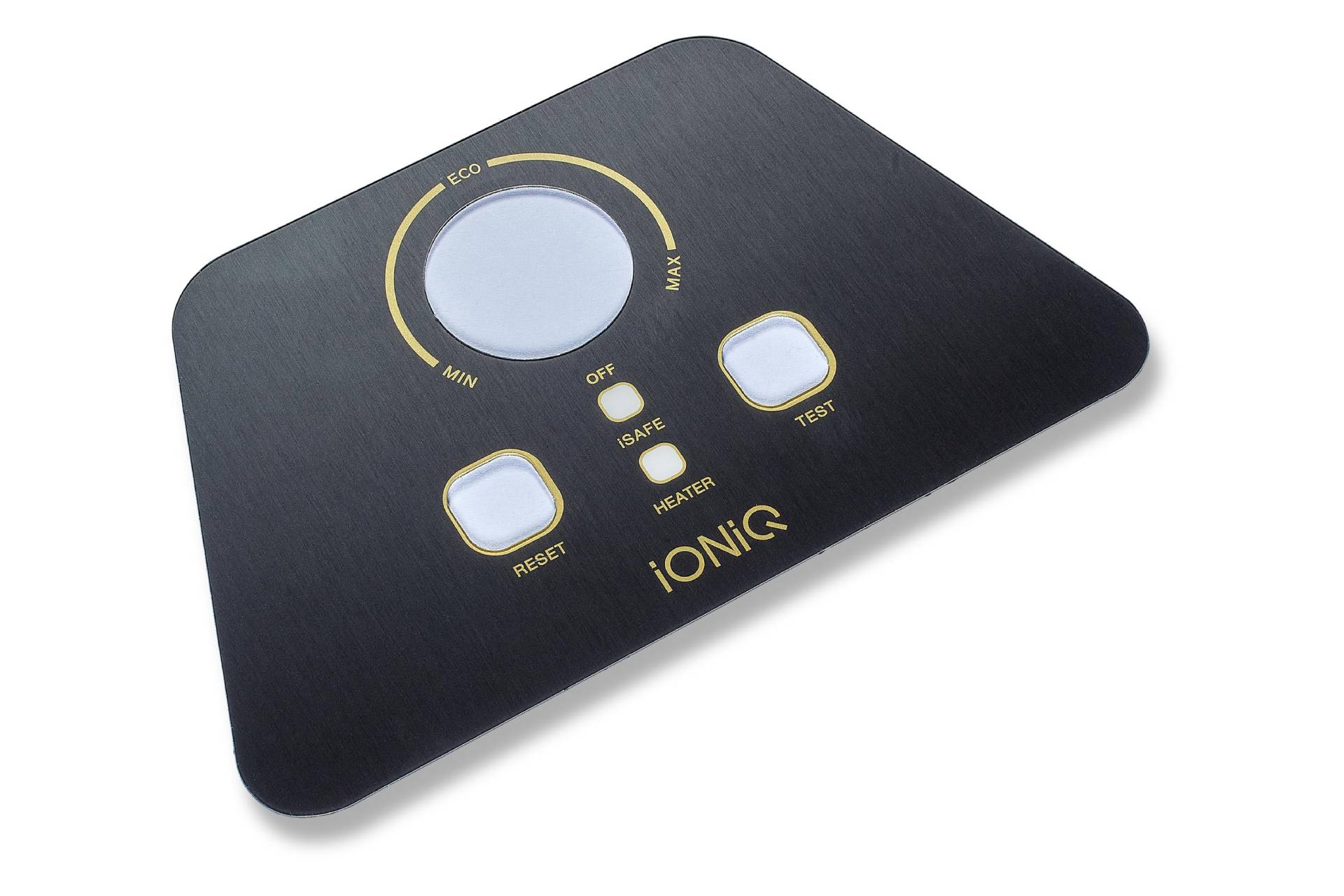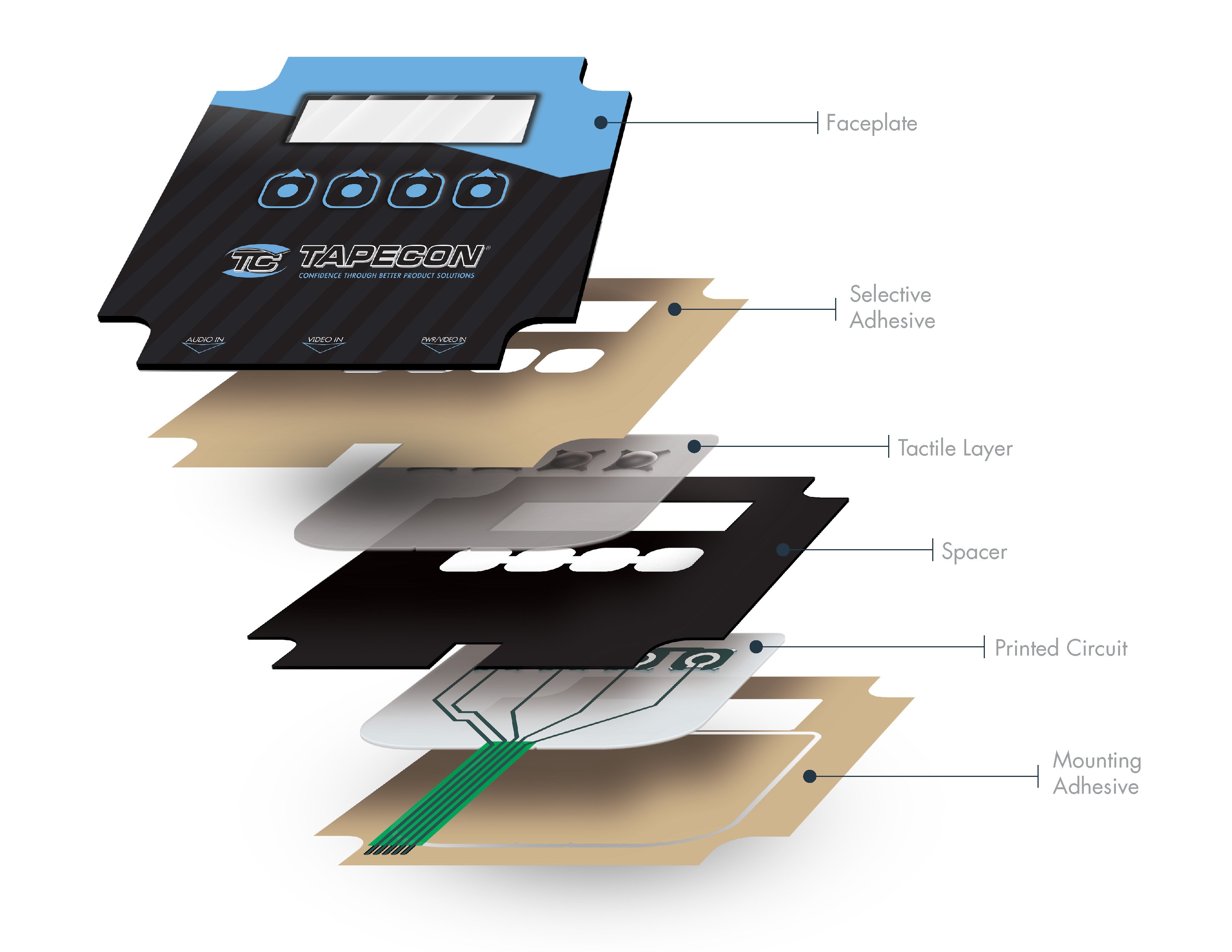Modern Technology from a Top Membrane Switch Manufacturer
Exactly How Membrane Switch Modern Technology Functions and Its Function in Customer Interface Layout
Membrane button technology is an innovative method that integrates split materials for touch-sensitive input. Its style includes graphic overlays, conductive layers, and glue elements that connect when pressed. This interaction not only finishes an electrical circuit yet likewise influences the total user experience. Comprehending the intricacies of this innovation exposes its considerable effect on individual interface layout, prompting concerns concerning its applications and future advancements in various industries.
Recognizing Membrane Switch Technology
Membrane button technology acts as an essential component in modern individual interface design. This technology incorporates graphic overlays, touch-sensitive membrane layers, and circuit layers to develop a small, reputable input approach for different gadgets. The layout commonly consists of numerous layers, including a printed graphic layer that enables individuals to connect with the device via responsive feedback. Membrane buttons are recognized for their resilience, resistance to dampness, and simplicity of cleansing, making them ideal for settings where traditional mechanical buttons may stop working. Their low-profile layout enables smooth combination right into devices, adding to a smooth appearance. Additionally, Membrane buttons can be customized with different colors, structures, and icons, boosting user experience and aesthetic appeal. This flexibility makes them popular in consumer electronics, medical devices, and commercial controls, where user-friendly interaction is necessary. On the whole, Membrane button technology stands for a significant development in just how customers involve with electronic user interfaces.
Key Parts of Membrane Switches Over
Membrane switches over are composed of several key components that add to their performance and style. The conductive layer products, glue and support layers, and visuals overlay layout each play a crucial role in guaranteeing perfect efficiency and individual communication. Comprehending these components is essential for effective customer interface design.
Conductive Layer Materials
Conductive layer products play an important function in the performance and dependability of Membrane switches. These products are responsible for completing electrical circuits when stress is applied to the switch. Commonly, a mix of conductive inks, such as silver or carbon, is used to produce these layers. Silver conductive ink is favored for its exceptional conductivity and sturdiness, while carbon ink is often used for economical applications. The option of material impacts not only the electrical efficiency yet likewise the general life-span of the button. In addition, the density and composition of conductive layers can influence tactile feedback and button actuation. Picking the ideal conductive material is crucial for guaranteeing perfect performance in varied individual interface applications.
Sticky and Support Layers
Sticky and support layers are crucial components that add to the structural stability and capability of Membrane buttons. These layers give a durable foundation, guaranteeing that the numerous elements of the Membrane button continue to be securely adhered and effectively straightened throughout their operational life. The sticky layer helps with the accessory of the button to the underlying surface, offering resilience against ecological aspects such as moisture, temperature level variations, and mechanical stress. At the same time, assistance layers improve the button's rigidity, protecting against deformation during use and contributing to a regular tactile action. With each other, these parts play a vital duty in keeping the efficiency and durability of Membrane switches, eventually influencing the overall customer experience in user interface style.
Graphic Overlay Style
Although commonly forgotten, visuals overlay style plays a necessary role in the functionality and visual appeals of Membrane switches. This design mostly acts as the interface in between the individual and the electronic devices, offering both visual charm and operational quality. Reliable visuals overlays utilize shade, typography, and icons to direct individuals in maneuvering controls and recognizing device functions. Furthermore, the selection of products influences longevity and tactile responses, making certain the overlay holds up against wear while preserving a pleasant user experience. Furthermore, exact placement of the overlay with the underlying components is essential for optimal efficiency. To conclude, thoughtful visuals overlay design boosts use, contributes to brand identity, and ultimately affects user contentment in gadgets using Membrane switch innovation.
The Production Process of Membrane Switches
The production procedure of Membrane switches involves several important steps that ensure functionality and sturdiness. Originally, a visuals overlay is made, incorporating interface aspects and branding. This overlay is printed onto a versatile substratum, generally polyester or polycarbonate, utilizing precision printing strategies to identify clarity and color accuracy.Next, sticky layers are applied, complied with by the integration of conductive traces, commonly made from silver or carbon, which are important for electrical connection. These traces are etched or screen-printed onto a different layer. Hereafter, a spacer layer is included to create the required space between the overlay and the circuit layer, allowing for responsive responses when activated.Finally, the components are assembled and evaluated for top quality guarantee, ensuring that each Membrane switch satisfies the required specs for performance and reliability. This careful procedure causes a robust item fit for various applications in interface design.
Advantages of Making Use Of Membrane Changes

Membrane switches over offer numerous advantages that make them a favored option in user interface style. One significant advantage is their light-weight and small nature, enabling for streamlined styles in numerous applications. Additionally, Membrane buttons supply a sealed user interface, safeguarding against dirt, dampness, and pollutants, which improves toughness and reliability. They are likewise very personalized, enabling developers to create unique graphics and formats customized to specific user needs.Another advantage is their cost-effectiveness, as they normally require much less material and labor contrasted see page to typical buttons. The tactile responses of Membrane buttons can be engineered to boost user experience, offering a gratifying response without the mass of mechanical components. Furthermore, Membrane buttons can be conveniently integrated right into varied environments, such as clinical gadgets, industrial devices, and customer electronic devices. Overall, these advantages highlight the expanding popularity of Membrane switches in contemporary interface layout.
Applications in Various Industries
Extensively utilized throughout different markets, Membrane switch innovation has found its location in applications ranging from clinical tools to consumer electronics. In the health care market, these switches are indispensable to tools such as analysis devices and person surveillance systems, providing durable, easy-to-clean user interfaces that hold up against sterilization procedures. The automotive market uses Membrane buttons in control panels and control panels, giving trustworthy procedure in tough environments.Consumer electronic devices, consisting of home devices and video gaming consoles, advantage from the see page sleek style and customizability of Membrane switches, boosting customer communication. Furthermore, industrial machinery utilizes these buttons for control panels, guaranteeing resistance to dust and dampness while maintaining functionality.Moreover, the aerospace and military markets use Membrane switches for rugged applications, where integrity and efficiency are vital. On the whole, Membrane button modern technology offers varied markets by incorporating functionality, resilience, and aesthetic charm, making it a versatile selection for modern-day customer interfaces.

Creating Individual User Interfaces With Membrane Switches Over
When making individual interfaces with Membrane buttons, cautious consideration of both performance and visual appeal is vital. Membrane changes provide a streamlined, inconspicuous design that can enhance aesthetic charm while maintaining functionality. Developers must concentrate on switch format, ensuring intuitive positioning for simplicity of operation. The tactile feedback given by the Membrane switch is important; it can influence user contentment and overall experience.Additionally, color and visuals aspects must line up with the brand identity, reinforcing recognition and experience. Choosing long lasting materials that stand up to damage is also vital, as longevity adds to functionality over time. Incorporating backlighting can improve presence in various lights conditions, further improving user communication. Ultimately, a well-designed Membrane switch user interface balances both kind and function, guaranteeing that the user experience is both effective and interesting, meeting the needs of diverse applications across industries.
Future Trends in Membrane Switch Modern Technology
As Membrane button technology develops, the assimilation of smart performances is coming to be increasingly prominent. These innovations make it possible for enhanced interactivity and connection within interface (membrane switch manufacturer). Additionally, the change in the direction of eco-friendly materials mirrors a growing commitment to sustainability in style techniques
Smart Membrane Switches

Eco-Friendly Products Usage
In the middle of the innovations in Membrane switch innovation, a substantial pattern is arising in the direction of the use of environment-friendly products. Manufacturers are increasingly prioritizing sustainability by including non-toxic inks and biodegradable plastics, decreasing ecological influence. This shift not only lines up with worldwide ecological criteria yet likewise addresses customer need for greener items. Technologies in product science have actually enabled the development of resilient, environment-friendly options that preserve performance without jeopardizing top quality. These materials offer comparable functionality to traditional options while minimizing waste and toxicity. As industries come to be more eco-conscious, the assimilation of lasting methods in Membrane switch production is expected to climb, enhancing a dedication to environmental duty and leading the way for more sustainable user interface remedies in the future.
Frequently Asked Inquiries
Exactly How Do Membrane Switches Over Differ From Conventional Mechanical Buttons?
Membrane changes differ from conventional mechanical switches primarily in building and construction and operation. They make use of versatile layers that produce a secured interface, whereas mechanical buttons depend on physical activity and get in touch with, resulting in unique durability and responsive feedback characteristics.
Can Membrane Switches Be Personalized for Particular Applications?
Membrane switches can certainly be tailored for particular applications - membrane switch manufacturer. Producers design them to fulfill distinct demands, enabling tailored designs, graphics, and performances that improve customer interaction and fit particular operational requirements successfully
What Is the Life expectancy of a Membrane Layer Switch?
The life-span of a membrane layer switch usually ranges from 1 to 5 million actuations, depending upon variables such as worldly high quality, ecological conditions, and use frequency. Routine screening can assist establish its durability and look at this now integrity in applications.
Are Membrane Changes Water-proof or Resistant to Chemicals?
Membrane switches can be created to be immune and waterproof to chemicals, depending on the materials used and manufacturing processes. Appropriate sealing and protective finishings enhance their resilience in numerous ecological conditions and applications.
Just How Do Membrane Changes Impact Gadget Energy Consumption?
Membrane switches can substantially impact gadget power usage by ensuring efficient operation. Their reduced power demands throughout activation aid reduce energy usage, adding to longer battery life and general enhanced performance in digital tools. Membrane buttons are understood for their toughness, resistance to dampness, and ease of cleaning, making them appropriate for environments where conventional mechanical buttons might stop working. The vehicle sector utilizes Membrane switches in control panels and control panels, giving dependable procedure in challenging environments.Consumer electronics, including home devices and gaming consoles, benefit from the sleek layout and customizability of Membrane buttons, boosting individual communication. Additionally, commercial machinery makes use of these buttons for control panels, guaranteeing resistance to dirt and moisture while maintaining functionality.Moreover, the aerospace and military sectors make use of Membrane switches for rugged applications, where dependability and efficiency are essential. The advancement of Membrane switch technology is going into an amazing phase with the emergence of clever Membrane switches, which incorporate advanced attributes and functionalities. Membrane switches over differ from typical mechanical buttons mainly in construction and procedure.